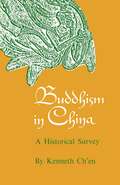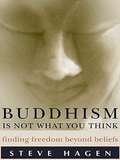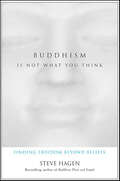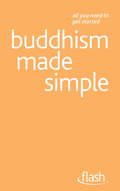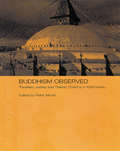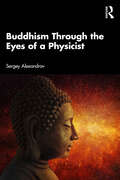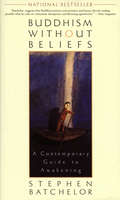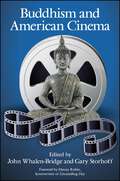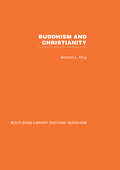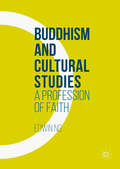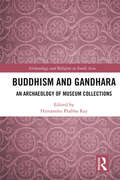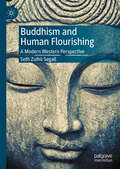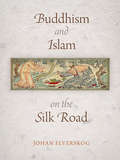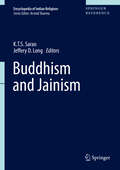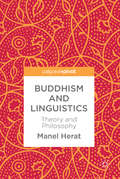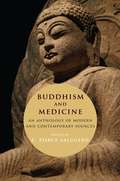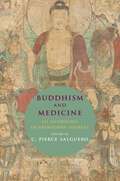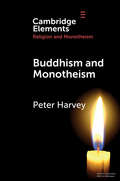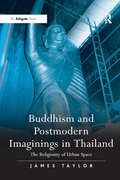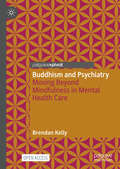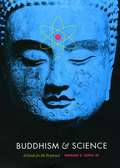- Table View
- List View
Buddhism In China: A Historical Survey
by Kenneth Ch'EnThis book is written primarily for those people who already have a general acquaintance with the history and religions of the Far East, with some particular interest in Chinese history and civilization, and who desire to know more about the development of Buddhism in China. It will serve also as a useful source of collateral readings for courses dealing with the history and culture of China and East Asia.
Buddhism Is Not What You Think: Finding Freedom Beyond Beliefs
by Steve HagenAccomplished Zen teacher explores some of the religions most essential questions. Draws on life experience and stories of various Buddhist teachers in order to dispel misconceptions and educate on topics such as wisdom, compassion, awareness, and what it means to be awake. Written in prose, The author's words are meant to appeal to newcomers and those who are already familiar with the faith. Hagen explains that Buddhism is based on life experience and not just thoughts about experience. The book aims to guide the reader towards a path to joy and freedom.
Buddhism Is Not What You Think: Finding Freedom Beyond Beliefs
by Steve HagenA practical, straight-forward guide to the true purpose of Buddhism, examining the essential & enduring questions at the heart of the Buddha’s teachings.Bestselling author and renowned Zen teacher Steve Hagen penetrates the most essential and enduring questions at the heart of the Buddha’s teachings: How can we see the world in each moment, rather than merely as what we think, hope, or fear it is? How can we base our actions on reality, rather than on the longing and loathing of our hearts and minds? How can we live lives that are wise, compassionate, and in tune with reality? And how can we separate the wisdom of Buddhism from the cultural trappings and misconceptions that have come to be associated with it?Drawing on down-to-earth examples from everyday life and stories from Buddhist teachers past and present, Hagen tackles these fundamental inquiries with his trademark lucid, straightforward prose. The newcomer to Buddhism will be inspired by this accessible and provocative introduction, and those more familiar with Buddhism will welcome this much needed hands-on guide to understanding what it truly means to be awake. By being challenged to question what we take for granted. We come to see the world as it truly is. Buddhism Is Not What You Think offers a profound and clear path to joy and freedom.Praise for Buddhism Is Not What You Think “Hagen’s writing flows in a tranquil way, like a spring trickling up effortlessly from the earth. One tends to stop judging it and just appreciate it for its own sake. Since this appreciation is his advice for dealing with everything, the sentences themselves actually create what they are describing.” —Robert M. Pirsig, author of Zen and the Art of Motorcycle Maintenance“This is not just another nice book about Buddhism, one telling us what we like to hear and are used to hearing. No—it is a clear and challenging showing of the fundamental truth of our lives. This is an exceptional book. Make good use of it.” —Charlotte Joko Beck, author of Everyday Zen
Buddhism Made Simple: Flash
by Clive ErrickerThe books in this bite-sized new series contain no complicated techniques or tricky materials, making them ideal for the busy, the time-pressured or the merely curious. Buddhism Made Simple is a short, simple and to-the-point guide to Buddhism. In just 96 pages, the reader will learn all about the history, beliefs and traditions of this major world faith. Ideal for the busy, the time-pressured or the merely curious, Buddhism Made Simple is a quick, no-effort way to break into this fascinating topic.
Buddhism Made Simple: Flash
by Clive ErrickerThe books in this bite-sized new series contain no complicated techniques or tricky materials, making them ideal for the busy, the time-pressured or the merely curious. Buddhism Made Simple is a short, simple and to-the-point guide to Buddhism. In just 96 pages, the reader will learn all about the history, beliefs and traditions of this major world faith. Ideal for the busy, the time-pressured or the merely curious, Buddhism Made Simple is a quick, no-effort way to break into this fascinating topic.
Buddhism Observed: Travellers, Exiles and Tibetan Dharma in Kathmandu (Anthropology of Asia)
by Peter MoranHow do contemporary Westerners and Tibetans understand not only what it means to be 'Buddhist', but what it means to be hailed as one from 'the West' or from 'Tibet'? This anthropological study examines the encounter between Western travellers and Tibetan exiles in Bodhanath, on the outskirts of Kathmandu, Nepal and analyses the importance of Buddhism in discussions of political, cultural and religious identity. Based on extensive field research in Nepal, Buddhism Observed questions traditional assumptions about Buddhism and examines the rarely considered phenomenon of Western conversions to a non-Western religion. Scholars of Anthropology, Religion and Cultural Studies will find here a refreshing insight into how to approach 'other' societies, religions and cultures.
Buddhism Plain and Simple
by Steven HagenBuddhism Plain and Simple offers a clear, straightforward treatise on Buddhism in general and on awareness in particular.When Buddha was asked to sum up his teaching in a single world, he said, "Awareness." The Buddha taught how to see directly into the nature of experience. His observations and insights are plain, practical, and down-to-earth, and they deal exclusively with the present.Longtime teacher of Buddhism Steve Hagan presents the Buddha's uncluttered, original teachings in everyday, accessible language unencumbered by religious ritual, tradition, or belief.
Buddhism Plain and Simple
by Steven HagenBuddhism Plain and Simple offers a clear, straightforward treatise on Buddhism in general and on awareness in particular.When Buddha was asked to sum up his teaching in a single world, he said, "Awareness." The Buddha taught how to see directly into the nature of experience. His observations and insights are plain, practical, and down-to-earth, and they deal exclusively with the present.Longtime teacher of Buddhism Steve Hagan presents the Buddha's uncluttered, original teachings in everyday, accessible language unencumbered by religious ritual, tradition, or belief.
Buddhism Through the Eyes of a Physicist
by Sergey AlexandrovThis book presents a view of Buddhism from the perspective of a theoretical physicist. It helps the reader comprehend deep Buddhist ideas by bringing them closer to a more familiar context. Concentrating on teachings of Mahayana school represented by Tibetan Buddhism, their structure and main ideas are compared with the structure of scientific theory and the modern understanding of the laws of the Universe. It particularly explains in simple terms how attempts to construct a theory of quantum gravity have led to discoveries, not yet covered in the popular science literature, which drastically change our ideas about the nature of matter, space and time, and why the resulting picture of the world nicely agrees with the Buddhist doctrine of emptiness. The book also addresses several misinterpretations and misconceptions appearing from time to time in the literature and private discussions.The volume will be of great interest to general readers as well as scholars and researchers of religion and science and technology studies.
Buddhism Without Beliefs: A Contemporary Guide to Awakening
by Stephen BatchelorA national bestseller and acclaimed guide to Buddhism for beginners and practitioners alike In this simple but important volume, Stephen Batchelor reminds us that the Buddha was not a mystic who claimed privileged, esoteric knowledge of the universe, but a man who challenged us to understand the nature of anguish, let go of its origins, and bring into being a way of life that is available to us all. The concepts and practices of Buddhism, says Batchelor, are not something to believe in but something to do--and as he explains clearly and compellingly, it is a practice that we can engage in, regardless of our background or beliefs, as we live every day on the path to spiritual enlightenment.
Buddhism and American Cinema (SUNY series in Buddhism and American Culture)
by John Whalen-Bridge; Gary StorhoffIn 1989, the same year the Dalai Lama was awarded the Nobel Peace Prize, a decade-long boom of films dedicated to Buddhist people, history, and culture began. Offering the first scholarly treatment of Buddhism and cinema, the editors advise that there are two kinds of Buddhist film: those that are about Buddhists and those that are not. Focusing on contemporary American offerings, the contributors extend a two-pronged approach, discussing how Buddhism has been captured by directors and presenting Buddhist-oriented critiques of the worlds represented in films that would seem to have no connection with Buddhism. Films discussed range from those set in Tibet, such as Kundun and Lost Horizon, to those set well outside of any Buddhist milieu, such as Groundhog Day and The Matrix. The contributors explain the Buddhist theoretical concepts that emerge in these works, including karma, the bardo, and reincarnation, and consider them in relation to interpretive strategies that include feminism, postcolonialism, and contemplative psychological approaches.
Buddhism and Christianity: Some Bridges of Understanding (Routledge Library Editions: Buddhism)
by Winston L KingAfter a brief historical survey, the doctrines of dharma and karma are discussed and key elements that appear in contrasting forms in the two religions are examined. Originally published in 1963.
Buddhism and Cultural Studies: A Profession of Faith
by Edwin NgThis book explores the reciprocity between Buddhist, Derridean, and Foucauldian understandings about ethics, subjectivity, and ontological contingency, to investigate the ethical and political potential of insight meditation practice. The book is narrated from the perspective of a postcolonial 'Western Buddhist' convert who, despite growing up in Singapore where Buddhism was a part of his disaporic 'Chinese' ancestral heritage, only embraced Buddhism when he migrated to Australia and discovered Western translations of Buddhist teachings. Through an autoethnography of the author's Buddhist-inspired pursuit of an academic profession, the book develops and professes a non-doctrinal understanding of faith that may be pertinent to 'believers' and 'non-believers' alike, inviting the academic reader in particular to consider the (unacknowledged) role of faith in supporting scholarly practice. Striking a careful balance between critical analysis and self-reflexive inquiry, the book performs in all senses of the word, a profession of faith.
Buddhism and Gandhara: An Archaeology of Museum Collections (Archaeology and Religion in South Asia)
by Himanshu Prabha RayGandhara is a name central to Buddhist heritage and iconography. It is the ancient name of a region in present-day Pakistan, bounded on the west by the Hindu Kush mountain range and to the north by the foothills of the Himalayas. ‘Gandhara’ is also the term given to this region’s sculptural and architectural features between the first and sixth centuries CE. This book re-examines the archaeological material excavated in the region in the nineteenth and early twentieth centuries and traces the link between archaeological work, histories of museum collections and related interpretations by art historians. The essays in the volume underscore the diverse cultural traditions of Gandhara – from a variety of sources and perspectives on language, ethnicity and material culture (including classical accounts, Chinese writings, coins and Sanskrit epics) – as well as interrogate the grand narrative of Hellenism of which Gandhara has been a part. The book explores the making of collections of what came to be described as Gandhara art and reviews the Buddhist artistic tradition through notions of mobility and dynamic networks of transmission. Wide ranging and rigorous, this volume will appeal to scholars and researchers of early South Asian history, archaeology, religion (especially Buddhist studies), art history and museums.
Buddhism and Human Flourishing: A Modern Western Perspective
by Seth Zuihō SegallThe Buddha and Aristotle offer competing visions of the best possible life to which human beings can aspire. In this volume, Seth Zuihō Segall compares Theravāda and Mahāyāna accounts of enlightenment with Aristotelian and neo-Aristotelian accounts of eudaimonia, and proposes a syncretic model of eudaimonic enlightenment that, given prevalent Western beliefs about well-being and human flourishing, provides a credible new end-goal for modern Western Buddhist practice. He then demonstrates how this proposed synthesis is already deeply reflected in contemporary Western Buddhist rhetoric. Segall re-evaluates traditional Buddhist teachings on desire, attachment, aversion, nirvāṇa, and selfhood from the eudaimonic enlightenment perspective, and explores the perspective’s ethical and metaphysical implications.
Buddhism and Islam on the Silk Road
by Johan ElverskogIn the contemporary world the meeting of Buddhism and Islam is most often imagined as one of violent confrontation. Indeed, the Taliban's destruction of the Bamiyan Buddhas in 2001 seemed not only to reenact the infamous Muslim destruction of Nalanda monastery in the thirteenth century but also to reaffirm the stereotypes of Buddhism as a peaceful, rational philosophy and Islam as an inherently violent and irrational religion. But if Buddhist-Muslim history was simply repeated instances of Muslim militants attacking representations of the Buddha, how had the Bamiyan Buddha statues survived thirteen hundred years of Muslim rule?Buddhism and Islam on the Silk Road demonstrates that the history of Buddhist-Muslim interaction is much richer and more complex than many assume. This groundbreaking book covers Inner Asia from the eighth century through the Mongol empire and to the end of the Qing dynasty in the late nineteenth century. By exploring the meetings between Buddhists and Muslims along the Silk Road from Iran to China over more than a millennium, Johan Elverskog reveals that this long encounter was actually one of profound cross-cultural exchange in which two religious traditions were not only enriched but transformed in many ways.
Buddhism and Jainism (Encyclopedia of Indian Religions)
by K. T. S. Sarao Jeffery D. LongThis volume focuses on Buddhism and Jainism, two religions which, together with Hinduism, constitute the three pillars of Indic religious tradition in its classical formulation. It explores their history and relates how the Vedic period in the history of Hinduism drew to a close around the sixth century BCE and how its gradual etiolation gave rise to a number of religious movements. While some of these remained within the fold of the Vedic traditions, others arose in a context of a more ambiguous relationship between the two. Two of these have survived to the present day as Buddhism and Jainism. The volume describes the major role Buddhism played in the history not only of India but of Asia, and now the world as well, and the more confined role of Jainism in India until relatively recent times. It examines the followers of these religions and their influence on the Indian religious landscape. In addition, it depicts the transformative effect on existing traditions of the encounter of Hinduism with these two religions, as well as the fertile interaction between the three. The book shows how Buddhism and Jainism share the basic concepts of karma, rebirth, and liberation with Hinduism while giving them their own hue, and how they differ from the Hindu tradition in their understanding of the role of the Vedas, the “caste system,” and ritualism in religious life. The volume contributes to the debate on whether the proper way of describing the relationship between the three major components of the classical Indic tradition is to treat them as siblings (sometimes as even exhibiting sibling rivalry), or as friends (sometimes even exhibiting schadenfreude), or as radical alternatives to one another, or all of these at different points in time.
Buddhism and Law
by Rebecca Redwood French Mark A. NathanAs the first comprehensive study of Buddhism and law in Asia, this interdisciplinary volume challenges the concept of Buddhism as an apolitical religion without implications for law. Buddhism and Law draws on the expertise of the foremost scholars in Buddhist studies and in law to trace the legal aspects of the religion from the time of the Buddha to the present. In some cases, Buddhism provided the crucial architecture for legal ideologies and secular law codes, while in other cases it had to contend with a preexisting legal system, to which it added a new layer of complexity. The wide-ranging studies in this book reveal a diversity of relationships between Buddhist monastic codes and secular legal systems in terms of substantive rules, factoring, and ritual practices. This volume will be an essential resource for all students and teachers in Buddhist studies, law and religion, and comparative law.
Buddhism and Linguistics: Theory and Philosophy
by Manel HeratThis edited collection brings linguistics into contact with a millennia of works by Buddhist scholars. Examining the Buddhist contemplative tradition and its extensive writings from an interdisciplinary perspective, the authors bridge the gap between such customs and human language. To do so, they provide chapters on linguistics, history, religious studies, philosophy and semiotics. Uniting scholars from three different continents and from many disciplines and institutions, this innovative and unique book is sure to appeal to anyone interested in Buddhist traditions and linguistics.
Buddhism and Medicine: An Anthology of Modern and Contemporary Sources
by C. Pierce SalgueroOver the centuries, Buddhist ideas have influenced medical thought and practice in complex and varied ways in diverse regions and cultures. A companion to Buddhism and Medicine: An Anthology of Premodern Sources, this work presents a collection of modern and contemporary texts and conversations from across the Buddhist world dealing with the multifaceted relationship between Buddhism and medicine.Covering the early modern period to the present, this anthology focuses on the many ways Buddhism and medicine were shaped by the forces of colonialism, science, and globalization, as well as ruptures and reconciliations between tradition and modernity. Editor C. Pierce Salguero and an international collection of scholars highlight diversity and innovation in the encounters between Buddhist and medical thought. The chapters contain a wide range of sources presenting different perspectives rooted in distinct times and places, including translations of published and unpublished documents and transcripts of ethnographic interviews as well as accounts by missionaries and colonial authorities and materials from the contemporary United States and United Kingdom. Together, these varied sources illustrate the many intersections of Buddhism and medicine in the past and how this nexus continues to be crucial in today’s global context.
Buddhism and Medicine: An Anthology of Premodern Sources
by C. Pierce SalgueroFrom its earliest days, Buddhism has been closely intertwined with medicine. Buddhism and Medicine is a singular collection showcasing the generative relationship and mutual influence between these fields across premodern Asia. The anthology combines dozens of English-language translations of premodern Buddhist texts with contextualizing introductions by leading international scholars in Buddhist studies, the history of medicine, and a range of other fields.These sources explore in detail medical topics ranging from the development of fetal anatomy in the womb to nursing, hospice, dietary regimen, magical powers, visualization, and other healing knowledge. Works translated here include meditation guides, popular narratives, ritual manuals, spells texts, monastic disciplinary codes, recipe inscriptions, philosophical treatises, poetry, works by physicians, and other genres. All together, these selections and their introductions provide a comprehensive overview of Buddhist healing throughout Asia. They also demonstrate the central place of healing in Buddhist practice and in the daily life of the premodern world.This anthology is a companion volume to Buddhism and Medicine: An Anthology of Modern and Contemporary Sources (Columbia, 2019).
Buddhism and Monotheism (Elements in Religion and Monotheism)
by Peter HarveyBuddhism is a religion lacking the idea of a unique creator God. It is a kind of trans-polytheism that accepts many long-lived gods, but sees ultimate reality, Nirvana, as beyond these. It does, though, see Dhamma/Dharma as a Basic Pattern encompassing everything, with karma as a law-like principle ensuring that good and bad actions have appropriate natural results. This Element explores these ideas, along with overlaps in Buddhist and monotheist ideas and practices, the development of more theist-like ideas in Mahāyāna Buddhism, Buddhist critiques of the idea of a creator God, and some contemporary Buddhist views and appreciations of monotheisms.
Buddhism and Postmodern Imaginings in Thailand: The Religiosity of Urban Space
by James TaylorThis book presents a rethink on the significance of Thai Buddhism in an increasingly complex and changing post-modern urban context, especially following the financial crisis of 1997. Defining the cultural nature of Thai ’urbanity’; the implications for local/global flows, interactions and emergent social formations, James Taylor opens up new possibilities in understanding the specificities of everyday urban life as this relates to perceptions, conceptions and lived experiences of religiosity. Changes in the centre are also reverberating in the remaining forests and the monastic tradition of forest-dwelling which has sourced most of the nation’s modern saints. The text is based on ethnography taking into account the rich variety of everyday practices in a mélange of the religious. In Thailand, Buddhism is so intimately interconnected with national identity and social, economic and ethno-political concerns as to be inseparable. Taylor argues here that in recent years there has been a marked reformulation of important conventional cosmologies through new and challenging Buddhist ideas and practices. These influences and changes are as much located outside as inside the Buddhist temples/monasteries.
Buddhism and Psychiatry: Moving Beyond Mindfulness in Mental Health Care
by Brendan KellyThis Open Access book explores the emergence of mindfulness from Buddhist tradition and its incorporation into contemporary mental health and social care. Mindfulness is a powerful technique, but it needs to be applied mindfully. Buddhist thought has older links with psychiatry and mental health care, prior to the current embrace of mindfulness, and these have not been articulated clearly over recent decades. These links are intrinsically valuable and have added relevance in an era of mindfulness. This book seeks to bring these associations and connections back to light and contextualise recent enthusiasm for mindfulness-based interventions. This book is aimed at readers who are interested in mental health, psychiatry, Buddhism, and mindfulness. These are all growing areas of interest and inquiry. This book is distinctive owing to its focus on links between psychiatry, mental health care, and Buddhism that include, but also move beyond, mindfulness. This book is also distinctive by virtue of the fact that it is written by someone who is both a psychiatrist in clinical practice and a researcher, as well as being qualified in Buddhist Studies (MA, University of Sunderland, 2010) and Mindfulness-Based Interventions (MSc, University College Dublin, 2023), and publishes across all of these fields.
Buddhism and Science: A Guide for the Perplexed
by Donald S. LopezBeginning in the nineteenth century and continuing to the present day, both Buddhists and admirers of Buddhism have proclaimed the compatibility of Buddhism and science. In "Buddhism and Science", Donald S. Lopez Jr. is less interested in evaluating the accuracy of such claims than in exploring how and why these two seemingly disparate modes of understanding, the inner and outer universes, have been so persistently linked.
